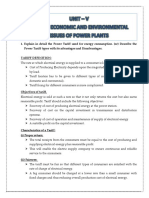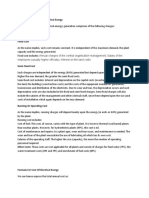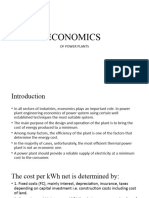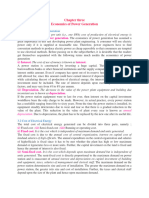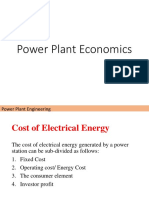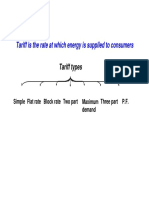0 ratings0% found this document useful (0 votes)
47 views7 Tariff
7 Tariff
Uploaded by
Parvathy Suresh1. The monthly bill for a consumer with a maximum demand of 50 kW, energy consumed of 36,000 kWh and reactive energy of 23,400 kVArh is calculated based on a tariff of Rs. 80/kW of maximum demand plus Rs. 8/kWh plus Rs. 0.5/kWh for every 1% pf is below 86%.
2. For a consumer with a maximum demand of 100 kW, pf of 0.8 lagging, and load factor of 60%, the annual bill under a tariff of Rs. 75/kVA of maximum demand plus Rs. 0.15/
Copyright:
© All Rights Reserved
Available Formats
Download as PPTX, PDF, TXT or read online from Scribd
7 Tariff
7 Tariff
Uploaded by
Parvathy Suresh0 ratings0% found this document useful (0 votes)
47 views22 pages1. The monthly bill for a consumer with a maximum demand of 50 kW, energy consumed of 36,000 kWh and reactive energy of 23,400 kVArh is calculated based on a tariff of Rs. 80/kW of maximum demand plus Rs. 8/kWh plus Rs. 0.5/kWh for every 1% pf is below 86%.
2. For a consumer with a maximum demand of 100 kW, pf of 0.8 lagging, and load factor of 60%, the annual bill under a tariff of Rs. 75/kVA of maximum demand plus Rs. 0.15/
Original Description:
Original Title
7.TARIFF
Copyright
© © All Rights Reserved
Available Formats
PPTX, PDF, TXT or read online from Scribd
Share this document
Did you find this document useful?
Is this content inappropriate?
1. The monthly bill for a consumer with a maximum demand of 50 kW, energy consumed of 36,000 kWh and reactive energy of 23,400 kVArh is calculated based on a tariff of Rs. 80/kW of maximum demand plus Rs. 8/kWh plus Rs. 0.5/kWh for every 1% pf is below 86%.
2. For a consumer with a maximum demand of 100 kW, pf of 0.8 lagging, and load factor of 60%, the annual bill under a tariff of Rs. 75/kVA of maximum demand plus Rs. 0.15/
Copyright:
© All Rights Reserved
Available Formats
Download as PPTX, PDF, TXT or read online from Scribd
Download as pptx, pdf, or txt
0 ratings0% found this document useful (0 votes)
47 views22 pages7 Tariff
7 Tariff
Uploaded by
Parvathy Suresh1. The monthly bill for a consumer with a maximum demand of 50 kW, energy consumed of 36,000 kWh and reactive energy of 23,400 kVArh is calculated based on a tariff of Rs. 80/kW of maximum demand plus Rs. 8/kWh plus Rs. 0.5/kWh for every 1% pf is below 86%.
2. For a consumer with a maximum demand of 100 kW, pf of 0.8 lagging, and load factor of 60%, the annual bill under a tariff of Rs. 75/kVA of maximum demand plus Rs. 0.15/
Copyright:
© All Rights Reserved
Available Formats
Download as PPTX, PDF, TXT or read online from Scribd
Download as pptx, pdf, or txt
You are on page 1of 22
TARIFF
Tariff : Rate at which electrical energy is supplied to a consumer
TYPES OF TARIFF:
1. SIMPLE TYPE OF TARIFF
= Annual fixed charges+ Annual running charges
Total no of units supplied to the consumers annually
Fixed rate per unit of energy consumed
No distinction between bulk consumers and domestic
consumers
Cost per unit calculated will be more
2. FLAT RATE TARIFF
Different types of consumers are charged at different rates
Consumers are grouped into residential, commercial etc.
Rates for each type of consumer is arrived at by taking into
account its load factor and diversity factor
Fig: Flat demand rate
z- Total cost
y- Energy consumed
2. Straight meter rate:
Simplest form of tariff
Charge per unit is constant
Charge depend on energy used
Commonly used for residential and commercial consumer
Does not encourage the use of electricity
3. BLOCK RATE TARIFF
A given block of energy is charged at a specified rate and the
succeeding blocks of energy are charged at progressively
reduced rates.
Provides an incentive to consume more electrical energy
Increases the load factor of the system
Cost of generation per unit is reduced
Fig: Block meter rate
z- Total cost
y- Energy consumed
4. TWO PART TARIFF (Hopkinson demand rate)
Rate of energy is charged on the basis of maximum demand of
the consumer and the units consumed.
Total charge= Fixed charge + Running charge
Fixed charge based on maximum demand
Running charge based on units consumed
Total charge= Rs (a*kW + b*kWh)
a : Charge per kW of maximum demand
b : Charge per kWh of energy consumed
Maximum demand is taken as the connected load
If the consumer uses electricity sparingly or if he is out of
station, unnecessarily he has to pay the fixed charge
Fig: Two part tariff
z- Total cost
y- Energy consumed
5. MAXIMUM DEMAND TARIFF
Similar to two part tariff; but the maximum demand of the
consumer is measured by a ‘Maximum Demand Meter’
installed at the premises of the consumer
6. POWER FACTOR TARIFFS
Power factor of the consumer’s load is considered.
I = P/ (V cosΦ)
Consumer having low power factor is penalized
a) kVA Maximum Demand Tariff
• Modified form of two part tariff
• Fixed charges based on maximum demand in kVA and
not in kW
• Lower the pf, greater will the contribution towards the
fixed charge.
• Encourages the consumer to operate their appliances at
improved power factor
b) Sliding Scale Tariff or Average Power Factor Tariff
• An average power factor, say 0.8 is taken as reference
• Additional charges on lower pf
• Discount on higher pf
c) kWh and kVARh Tariff
• Both active and reactive power demands are charged
separately
• Lower the pf, more the reactive power
7. THREE PART TARIFF (Doherty rate)
Total charge= Rs ( a + b*kW + c* kWh)
a: Fixed charge made during each billing.
It includes interest and depreciation on the cost of secondary
distribution and labour cost of collecting revenue as well as
meter rent
b : Charge per kW of maximum demand
c : Charge per kWh of energy consumed
Fig: Three part tariff
z- Total cost
y- Energy consumed
8. TIME-OF-DAY (T.O.D)
Charges extra for electricity during periods of high
demand and offers a discount rate during off-peak hrs.
The incentive encourages the consumer to use loads
during off-peak, lower rate periods, with the reward of
lower monthly electricity bill.
Cost Analysis
1. Capital Cost or Fixed Cost
• Initial Cost
Factors affecting cost of generating units
Location of plant
Time of construction
Size of units
Number of generating units
• Interest
• Depreciation
Straight line method
Percentage method
Sinking fund method
Unit method
2. Operational Cost
Cost of fuels
Labour cost
Cost for maintenance and repair
Supervision
Depreciation
i. Straight line method
• Simplest and commonly used method
• Life of equipment or enterprise is assessed first and residual or salvage
value is also estimated life
• Rate of depreciation is uniform throughout the life of the equipment
• Depreciation Formula for the Straight Line Method:
Depreciation Expense = (Cost – Salvage value) / Useful life
• Example: Consider a piece of equipment that costs $25,000 with an
estimated useful life of 8 years and a $0 salvage value. The depreciation
expense per year for this equipment would be as follows:
• Depreciation Expense = ($25,000 – $0) / 8 = $3,125 per year
Double Declining Balance Depreciation Method
• Results in larger expense in the earlier years as opposed to the later years
of an asset’s useful
• Assets are more productive in its early years than in its later years
• Double-declining-balance method, the depreciation factor is 2x that of a
straight line expense method
• Depreciation formula for the double declining balance method:
Periodic Depreciation Expense = Beginning book value x Rate of
depreciation
Example: Consider a piece of equipment that costs $250,000 with an
estimated useful life of 8 years and a $2,500 salvage value. To calculate
the double declining balance depreciation, set up a schedule:
Units of Production Depreciation Method
• Depreciates assets based on the total number of hours used or the total
number of units to be produced over its useful life
• Depreciation formula for the Units of Production depreciation
method:
Depreciation Expense = (Number of units produced / Life in
number of units) x (Cost – Salvage value)
Example: Consider a machine that costs $25,000 with an estimated total
unit production of 100 million and a $0 salvage value. During the first
quarter of activity, the machine produced 4 million units.
Depreciation Expense = (4 million / 100 million) x ($25,000 – $0) =
$1,000
Sum-of-the-Years-Digits Depreciation Method
A higher expense is incurred in the early years while lower expense is incurred in
the latter years of the asset
• Depreciation formula for the sum-of-the-years-digits method:
Depreciation Expense = (Remaining life / Sum of the years digits)
x (Cost – Salvage value)
Example: Consider a piece of equipment that costs $25,000 with an
estimated useful life of 8 years and a $0 salvage value. To calculate the
sum-of-the-years-digits depreciation method, set up a schedule:
Depreciation Base = Cost – Salvage value
Depreciation Base = $25,000 – $0 = $25,000
Summary of Depreciation Methods
• Below is the summary of all four depreciation methods from the examples
above.
• Summary Table of Depreciation by Method
1. The monthly readings of a consumer’s meter are as
follows: Maximum demand = 50 kW, Energy consumed
= 36,000 kWh, Reactive energy = 23,400 kVArh. If the
tariff is Rs.80/kW of maximum demand plus 8ps per
unit plus 0.5 ps per unit for each 1 % of pf below 86%,
calculate the monthly bill of the consumers.
2 Calculate annual bill of a consumer whose maximum
demand is 100 kW, pf = 0.8 lagging and load factor =
60%. The tariff used is Rs.75 per kVA of maximum
demand plus 15 paise per kWh consumed.
You might also like
- Understanding Gann Price and Time CycleDocument9 pagesUnderstanding Gann Price and Time CycleP Sahoo88% (8)
- Quality Control PlanDocument10 pagesQuality Control PlanGAURAV SHARMA100% (1)
- Energy Storage: Legal and Regulatory Challenges and OpportunitiesFrom EverandEnergy Storage: Legal and Regulatory Challenges and OpportunitiesNo ratings yet
- PowerDocument13 pagesPowerPralay RoyNo ratings yet
- TariffsDocument49 pagesTariffsvenki249No ratings yet
- Me8792-Power Plant Engineering-2108019826-Unit V - Energy and EconomicsDocument24 pagesMe8792-Power Plant Engineering-2108019826-Unit V - Energy and EconomicsNaavaneethNo ratings yet
- Chapter 4 Economics of Power GenerationDocument25 pagesChapter 4 Economics of Power GenerationkatlegoNo ratings yet
- Chapter 5 Tariff (Compatibility Mode)Document28 pagesChapter 5 Tariff (Compatibility Mode)katlegoNo ratings yet
- Factors Affecting The Electricity TariffsDocument10 pagesFactors Affecting The Electricity TariffsPoorna ChandarNo ratings yet
- 5-Unit IV - Economic Generation and UtilizationDocument50 pages5-Unit IV - Economic Generation and UtilizationVeera Vamsi YejjuNo ratings yet
- Desirable Characteristics of A Tariff: When There Is A Fixed Rate Per Unit of Energy ConsumedDocument4 pagesDesirable Characteristics of A Tariff: When There Is A Fixed Rate Per Unit of Energy ConsumedNishit KumarNo ratings yet
- Unit 5 PpeDocument78 pagesUnit 5 PpeJustin LivingstonNo ratings yet
- Ppe Unit 5 TarifsDocument6 pagesPpe Unit 5 TarifsCharyNo ratings yet
- Lecture 3Document48 pagesLecture 3jinanashraf02No ratings yet
- Module 2 - Week 2Document9 pagesModule 2 - Week 2Temp LordNo ratings yet
- Tariff PDFDocument3 pagesTariff PDFsushant7136100% (1)
- Unit VDocument29 pagesUnit Vprathamwakde681No ratings yet
- CH 1Document5 pagesCH 1imtisangyuNo ratings yet
- Assignment # 2 POWER ECONOMICDocument5 pagesAssignment # 2 POWER ECONOMICkhalidNo ratings yet
- Methods For Calculation of Tariff of Them: What Do You Understand by The Term Tariff? State The VariousDocument7 pagesMethods For Calculation of Tariff of Them: What Do You Understand by The Term Tariff? State The VariousNeel odedraNo ratings yet
- Experiment No 08Document7 pagesExperiment No 08shubhamNo ratings yet
- Cost of Power GenerationDocument12 pagesCost of Power GenerationPrasenjit GhoshNo ratings yet
- Chapter ThreeDocument50 pagesChapter ThreeHalu FikaduNo ratings yet
- TariffDocument30 pagesTariffvoltax1100% (3)
- Economics of Power Generation: Prepared By: Bhavin MehtaDocument21 pagesEconomics of Power Generation: Prepared By: Bhavin MehtaVinay MaisuriyaNo ratings yet
- Effect of Plant Type On RatesDocument4 pagesEffect of Plant Type On Ratesyosh gurtNo ratings yet
- Electricity TariffsDocument5 pagesElectricity TariffsaliNo ratings yet
- Format Technical Report WritingDocument9 pagesFormat Technical Report WritingREXGODNo ratings yet
- Document From Jitendra Nath RaiDocument27 pagesDocument From Jitendra Nath RaiVinit SinghNo ratings yet
- Power Generation and Distribution: Thomas K P Assistant Professor EEE RsetDocument30 pagesPower Generation and Distribution: Thomas K P Assistant Professor EEE RsetPalani PicoNo ratings yet
- Economics of Power Generation: by A. Prof. Dr. Wael M.El-MaghlanyDocument13 pagesEconomics of Power Generation: by A. Prof. Dr. Wael M.El-MaghlanyahmedaboshadyNo ratings yet
- Energy Meters RtomarDocument25 pagesEnergy Meters Rtomar21ume019No ratings yet
- Economics of Power PlantsDocument20 pagesEconomics of Power PlantsLawrence ChibvuriNo ratings yet
- TrarrifsDocument18 pagesTrarrifscja4326No ratings yet
- Unit 5Document87 pagesUnit 5er_sujithkumar13No ratings yet
- Module 5Document7 pagesModule 5Renuka KutteNo ratings yet
- Electricity BillDocument10 pagesElectricity Billfiroz.ahmedbaNo ratings yet
- Electricity TariffsDocument13 pagesElectricity TariffsKamesh Sarode100% (1)
- Lecture-7 (Eleectricity TARIFF System)Document58 pagesLecture-7 (Eleectricity TARIFF System)architectneha614No ratings yet
- Power System Economics NotesDocument83 pagesPower System Economics Notesdinesh100% (2)
- BenedictDocument11 pagesBenedictPralay RoyNo ratings yet
- Unit Ii Economics of Power GenerationDocument20 pagesUnit Ii Economics of Power GenerationLokeshwari GopinathNo ratings yet
- PPE - Lecture3Document37 pagesPPE - Lecture317027 A. F. M. Al MukitNo ratings yet
- Power Plant Module 1 For FINALS PDFDocument8 pagesPower Plant Module 1 For FINALS PDFRex Sotelo BaltazarNo ratings yet
- Electricity Tariff: Definition: The Amount of Money Frame by TheDocument15 pagesElectricity Tariff: Definition: The Amount of Money Frame by TheDhruvaNo ratings yet
- EE2004 5 TariffsDocument25 pagesEE2004 5 Tariffsanimation.yeungsinwaiNo ratings yet
- Lecture 3Document11 pagesLecture 3Awil MohamedNo ratings yet
- About Tariff BY Siddharth and VineetDocument12 pagesAbout Tariff BY Siddharth and Vineetsid tomarNo ratings yet
- Power GenerationDocument11 pagesPower GenerationPralay RoyNo ratings yet
- TariffDocument11 pagesTariffPralay RoyNo ratings yet
- Tariff Plan - PresentationDocument17 pagesTariff Plan - PresentationPrashant ChaharNo ratings yet
- Types of Tariff in The Power System-1Document5 pagesTypes of Tariff in The Power System-1Godspower ImonigbaborNo ratings yet
- X. Economics of Power PlantDocument11 pagesX. Economics of Power Plantreynaldgurion09No ratings yet
- PPE Lecture3Document25 pagesPPE Lecture3Alvin IsmailNo ratings yet
- Tariff Is The Rate at Which Energy Is Supplied To ConsumersDocument6 pagesTariff Is The Rate at Which Energy Is Supplied To ConsumersSakthi VelNo ratings yet
- DCB30082 Topic 1Document42 pagesDCB30082 Topic 1Aiman NaimNo ratings yet
- TariffDocument9 pagesTariffShantu AichNo ratings yet
- 02 Energy AccountingDocument44 pages02 Energy AccountingayariseifallahNo ratings yet
- Tariffs and Load Curves (Module-2) : Presenter: Harshit Srivastava Aditya Srivastava Sparsh GuptaDocument24 pagesTariffs and Load Curves (Module-2) : Presenter: Harshit Srivastava Aditya Srivastava Sparsh GuptaAditya SrivastavaNo ratings yet
- TARIFFSDocument32 pagesTARIFFStamann2004No ratings yet
- Objective of TariffDocument24 pagesObjective of TariffKeep ThrowNo ratings yet
- 7th Week TariffDocument15 pages7th Week TariffPankaj RajNo ratings yet
- SmartPlant Electrical Basic Training GuideDocument312 pagesSmartPlant Electrical Basic Training GuideParvathy Suresh100% (1)
- Work Study, Motion Study, Time StudyDocument8 pagesWork Study, Motion Study, Time StudyParvathy Suresh0% (1)
- OrganizingDocument87 pagesOrganizingParvathy SureshNo ratings yet
- Introduction To Management1Document83 pagesIntroduction To Management1Parvathy SureshNo ratings yet
- 3.energy SourcesDocument3 pages3.energy SourcesParvathy SureshNo ratings yet
- 3.energy SourcesDocument3 pages3.energy SourcesParvathy SureshNo ratings yet
- Energy Sources and Conversion ProcessesDocument3 pagesEnergy Sources and Conversion ProcessesParvathy SureshNo ratings yet
- Distributed Generation Microgrid Smart GridDocument30 pagesDistributed Generation Microgrid Smart GridParvathy SureshNo ratings yet
- Special MachinesDocument45 pagesSpecial MachinesParvathy SureshNo ratings yet
- TGEPL - Corporate Presentation - 24-2-2024Document75 pagesTGEPL - Corporate Presentation - 24-2-2024AylaNo ratings yet
- Daftar PustakaDocument1 pageDaftar PustakaFebryan PutraNo ratings yet
- Garcia'S Data Encoders Trial Balance MAY Account Title Debit CreditDocument4 pagesGarcia'S Data Encoders Trial Balance MAY Account Title Debit CreditChristel TacordaNo ratings yet
- Democratizing AIDocument3 pagesDemocratizing AIAltun HasanliNo ratings yet
- Group Assignment Alfy 602 2023Document3 pagesGroup Assignment Alfy 602 2023Sadrudin MabulaNo ratings yet
- MCQ Series-5 Applied Mathematics-XII (Application of Derivatives) M.C.Q.Document5 pagesMCQ Series-5 Applied Mathematics-XII (Application of Derivatives) M.C.Q.YashSukhwalNo ratings yet
- 33 SAc LJDocument42 pages33 SAc LJTheresa SinykinNo ratings yet
- BOQ Godrej Golf LInkDocument14 pagesBOQ Godrej Golf LInkBittudubey officialNo ratings yet
- Economic Holiday HomeworkDocument30 pagesEconomic Holiday HomeworkherculizNo ratings yet
- Problem Set1Document3 pagesProblem Set1Lê Hoàn Minh ĐăngNo ratings yet
- 60745-2.09-E-B1-210 - Electrical Services, Basement 1 - Proposed Containment LayoutDocument1 page60745-2.09-E-B1-210 - Electrical Services, Basement 1 - Proposed Containment LayoutAbiNo ratings yet
- Nasarawa State University, Keffi: Payer InformationDocument1 pageNasarawa State University, Keffi: Payer InformationBähd SamcaseNo ratings yet
- CWE19SP4NWW2Document44 pagesCWE19SP4NWW2usmanghani17201No ratings yet
- Jurnal Vini Alvionita D1A117363Document8 pagesJurnal Vini Alvionita D1A117363Insyira AfifahNo ratings yet
- Dealer Performance Report Jan 2021Document10 pagesDealer Performance Report Jan 2021Parts LiugongNo ratings yet
- Official Response From Suresh KalmadiDocument2 pagesOfficial Response From Suresh KalmadiNDTVNo ratings yet
- Root Cause Analysis Under Elevation Concrete and Rebar R10 UpdateDocument6 pagesRoot Cause Analysis Under Elevation Concrete and Rebar R10 Updateamirhamzah2503No ratings yet
- Global Trend Chapter ThreeDocument28 pagesGlobal Trend Chapter Threekaleab seleshi100% (1)
- HighAmbientTempMotors GB 04 - 2004Document12 pagesHighAmbientTempMotors GB 04 - 2004Alfredo Jose Ramirez MelgarejoNo ratings yet
- C1 Introduction+Global Strategy+GSCMDocument61 pagesC1 Introduction+Global Strategy+GSCMTho ThoNo ratings yet
- Edit - How Much Money Can You Make From Forex Trading PDFDocument12 pagesEdit - How Much Money Can You Make From Forex Trading PDFDominik Dagobert100% (2)
- Macroeconomics 2 (PMAK) : Discussion Session 5Document16 pagesMacroeconomics 2 (PMAK) : Discussion Session 5Sascha Christian SpringNo ratings yet
- Fiscal Responsibility and Budget Management ACT, 2003Document22 pagesFiscal Responsibility and Budget Management ACT, 2003Aakriti GuptaNo ratings yet
- Orchid CultivationDocument5 pagesOrchid Cultivationdevagiriss1No ratings yet
- Halifean Rentap - 2020836444 - Toturial 3 (A) - (B)Document4 pagesHalifean Rentap - 2020836444 - Toturial 3 (A) - (B)halifeanrentapNo ratings yet
- Profile 2-2023 (2)Document51 pagesProfile 2-2023 (2)Osama SharakyNo ratings yet
- Baren Report 06Document20 pagesBaren Report 06joshuaezekielmahinyilaNo ratings yet
- Investor Presentation - CRESCENT (Updated-19-06-2023)Document11 pagesInvestor Presentation - CRESCENT (Updated-19-06-2023)mudit methaNo ratings yet





